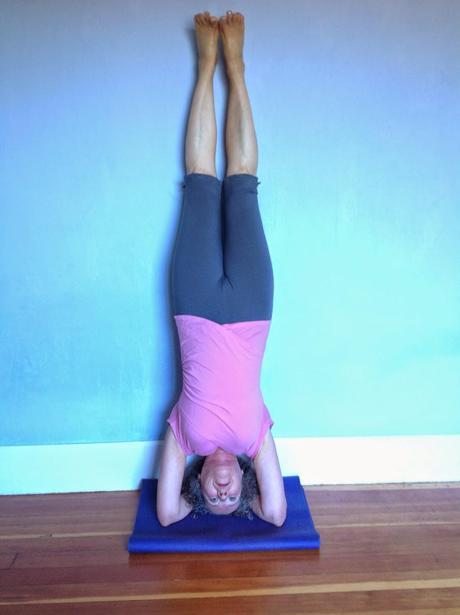 Q: Following the stressful weeks you have just been through, what kind of yoga practice are you craving and what will you include in your home practice to meet that desire?
Q: Following the stressful weeks you have just been through, what kind of yoga practice are you craving and what will you include in your home practice to meet that desire?A: After many, many years of practicing on my own, I do develop specific cravings for yoga poses, depending both on my emotional and physical state. In my case, stress affects me in a very distinctive way: I become hyper, a little manic, and I have a hard time sleeping. So what I really crave (and know from experience will work for me) during a stressful period is the calming superpowers of supported inverted poses (see All About Supported Inverted Poses and Why You Should Love Your Baroreceptors ). What I love about these poses is that they don’t take a lot of mental effort for me (I do breath practices as well but you have to focus on those). I just get myself into the poses, and the magic calming action just kicks in.
The two poses I crave the most are Legs Up the Wall pose (Viparita Karani) and Headstand (Sirsasana). Legs Up the Wall is a guaranteed stress buster for me, and sometimes if I don’t have time for a long practice, I’ll just do the pose on its own (see A Woman Did a Single Yoga Pose and What Happened Next Will Blow Your Mind). Headstand isn’t so much calming for me as grounding. Part of my stress response is to get very flighty and distracted (hahaha, my son recently observed that when I get hyper, I interrupt MYSELF while I’m talking). So if my practice is longer, I like to add Headstand to my sequence, along with its traditional counter-pose, Shoulderstand (Salamba Sarvangasana), and finish off with a long Legs Up the Wall pose.Yesterday I did my go-to stress reduction sequence, which is actually rather long (though very effective). I started with reclined leg stretches (see Featured Pose: Reclined Leg Stretch ) and hip openers, and then a long shoulder opener. These helped me prepare for the inverted poses, and also released held tension from my legs (I’ve been walking a lot). Then I did all the supported inverted poses, in the following order:
You can see photos of all these poses in my post All About Supported Inverted Poses. I do understand that some of those poses are not accessible to our readers (though you can do just the ones that are, skipping over the ones that aren’t). In the days to come, as I recover from a very stressful few weeks, I’m going to plan several sequences that prepare me for a nice, long Legs Up the Wall pose. For example, a series of straight leg standing poses (such as Triangle pose, Half Moon pose, and Pyramid pose) will prepare me for seated forward bends, and after a few seated forward bends, I’ll be all set for a nice Legs Up the Wall pose. (If I want to do Headstand again—actually I try to refrain from doing this every day to keep from overstressing my neck—I’ll put that and Shoulderstand before the seated forward bends). Or, I might do a few twisting standing poses (such as Revolved Triangle and Revolved Half Moon) and then some seated twists, ending with, yes, you guessed it, Legs Up the Wall pose. Headstand/Shoulderstand could come either before or after the seated twists. I will avoid active backbends for some time (I find these over-stimulating when I’m stressed), though I will do some passive backbends to keep my body balanced. At night, before sleep, I will do a short session of breath practice, where I lengthen my exhalations (see Yoga You Can Do in Bed and Yoga for Better Sleep). The hope is that by practicing conscious relaxation immediately before sleep, I’ll sleep more soundly. I do the same practice if I wake in the middle of the night and can’t get back to sleep.I do know that other people might find restorative yoga helpful when they are feeling stressed out (see Restorative Yoga: An Introduction). This is especially true for people who find inverted poses challenging, but I suspect it also has to do with natural temperament, maybe even according to Ayurvedic types. So I just don’t feel like practicing restorative yoga poses, unless I’m exhausted.
Q: Now, I’m curious about you, dear readers. What are your go-to asanas when you’re going through a stressful period or your nervous system feels over-stimulated? And why do you think those poses work well for you? Please let me know either in the comments section of this post or on our Facebook page.—Nina

